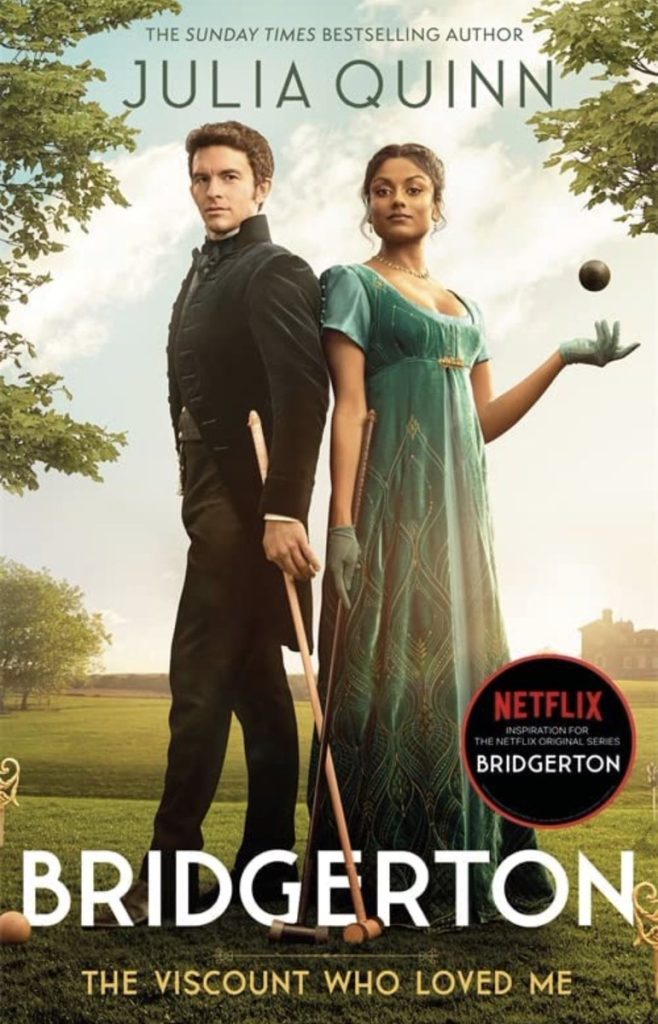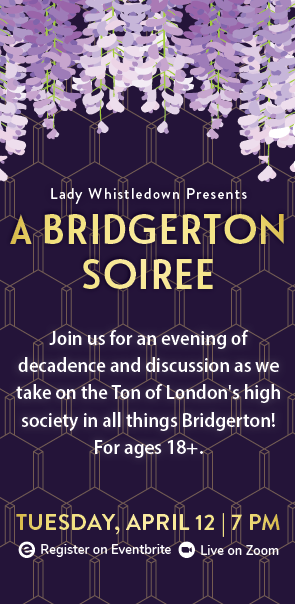On April 12, join us for Lady Whistledown Presents: A Bridgerton Soirée for an evening of decadence and discussion as we take on the Ton of London’s high society! For ages 18+.
When Brigderton first premiered on Christmas Day of 2020, it wasn’t long before streaming numbers exploded and the historical romance was crowned the most-streamed show in Netflix history. Despite the period setting, it always had the makings of a hit: a Shondaland production, a Jane Austen-meets-Gossip Girl (with an R rating) plot, gorgeous costumes, and an even more gorgeous cast. Throw in the fact that we were all still locked in our homes and needing some form of breezy distraction, and voila! The show has since been bumped from the top spot by Squid Game, but let’s see where season two lands. If you’re like me, you’ve probably devoured season two of Bridgerton by now—perhaps more than once.
Season two of the show is based on The Viscount Who Loved Me, book two in the Bridgerton book series by Julia Quinn. I confess that I myself have never read the books, so I can’t speak to the show’s faithfulness—but what I can speak to is the pivot to a more traditional Regency style: season two trades the graphic love scenes for simmering tension, barbed snipes, and charged glances. And honestly, the show is all the better for it. Our mains this season are Viscount Anthony Bridgerton, eldest of the siblings, and Miss Kate Sharma, who comes to England from India in order to find a match for her younger sister. It’s the enemies-to-lovers story we’ve been waiting for! Anyone who was despairing over the lack of season one’s Duke, do not fear: these two more than make up for the loss.
I’ve long been a fan of period dramas, and I’ve seen just about every Jane Austen adaption to date (you better believe I’m already hyped for the upcoming Persuasion movie starring Dakota Johnson). And I’m certainly not alone! Regency is the most popular subgenre of romance fiction; next time you’re at the library, just take note of how many paperbacks feature dukes and women in period-inappropriate dresses. It’s a lot! But what makes this extremely niche time period so alluring, 200 years later? The Regency period was, quite literally, only nine years in English history (1811-1820). Nine! So what gives?
The short-lived Regency era was ruled by the Prince Regent in place of his ill father, King George III. This prince wasn’t super concerned with running the country; a patron of the arts, he was just looking for a good time. And under him, the aristocracy flourished (the “bon ton”, or ton for short). It was also a time of considerable advancement in industry and science, meaning the people of the era would have been more modern than their medieval counterparts. Bridgerton author Julia Quinn astutely notes that “[the era] is modern enough that the way that they saw the world was not so fundamentally different than we do”. But it’s also long enough ago—and different enough from our own lives—that it feels just enough like a fantasy.
The birth of Regency romance was actually not Jane Austen, despite how many times I’ve mentioned her so far. Austen wrote during the Regency period, so her books are not historical fiction. They are also not, contrary to popular belief, romances; her work is described as “comedies of manners” or “country house novels” (or, as one Amazon review put it, “Just a bunch of people going to each other’s houses”). Regency romance is actually an invention of the 20th century, credited to Georgette Heyer. It features all the trappings from your traditional Regency novel (Empire dresses, top hats, cravats, manor houses, strict social norms) but with modern (by our standards) sensibilities. Regency romance has little to do with the actual time period, but rather “Like Tolkien, Heyer created a fictional world so sturdy that people could play with it for decades”.
One thing truly foreign to modern readers would be the archaic, entirely arbitrary social rules of the time. In Bridgerton, you better not be caught in a room alone with an eligible bachelor or bachelorette—you are now betrothed in the eyes of the ton! They are, simply, bonkers. But in romance land, the more rules there are, the more rules there are to break—and that makes for exciting reading/watching. In a world where virtually nothing is allowed, it’s easy to make little moments sizzle with tension. Take, for example, the moment in Pride and Prejudice (2005) when Mr. Darcy helps Elizabeth Bennet out of a carriage, and then flexes his hand. It’s a fleeting moment that has gone on to eclipse even the proposal as one of the most iconic romantic moments in the film (to be fair, the proposal is mostly a fight). In a modern romance, a hand flex wouldn’t even register. But in 1800s Derbyshire? Whew!
If you’re still swooning over Bridgerton’s second season (or even its first!), come find community at Lady Whistledown Presents: A Bridgerton Soirée! We’ll be chatting about our favourite moments (the bee sting? Eloise giving a piece of her mind to Penelope? Anthony’s Mr-Darcy-in-the-lake moment?) over a cup of the finest tea. We’ll even be learning the art of the fan; sure to come in handy while rewatching those Kate and Anthony (#Kanthony) scenes!

